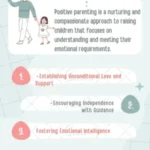Parenting is a wonderful journey filled with joy, challenges, and responsibilities. As parents, one of our most crucial tasks is to instill positive discipline in our children. Positive discipline is not about punishment or control, but rather about creating a nurturing environment that fosters a child’s emotional and behavioral development. In this article, we will explore the significance of positive discipline and how it can shape children into well-adjusted, confident, and compassionate individuals.
Understanding Positive Discipline
Positive discipline is a parenting approach based on mutual respect, understanding, and communication. Unlike traditional discipline methods that rely on fear and authority, positive discipline aims to teach children valuable life skills, self-regulation, and problem-solving abilities. By focusing on encouragement and empathy, parents can build a strong bond with their children, making them feel loved and supported.
Read also: Fun and Educational: 10 Indoor Games to Keep Your Kids Busy
The Core Principles of Positive Discipline
- Respect and Empathy: Treat children with respect, acknowledging their feelings and emotions. Empathize with their struggles, and show them that you understand and care.
- Clear Boundaries and Expectations: Set clear and age-appropriate boundaries for your child. Communicate your expectations effectively and consistently.
- Effective Communication: Encourage open communication with your child. Listen actively and patiently to what they have to say.
- Positive Reinforcement: Recognize and praise your child’s efforts and good behavior. Positive reinforcement enhances their self-esteem and motivation.
- Natural Consequences: Allow children to experience the natural consequences of their actions. This helps them understand responsibility and accountability.
Implementing Positive Discipline at Home
- Model Positive Behavior: Children learn by observing their parents. Demonstrate the behavior you wish to see in your child.
- Establish Routines: Routines provide structure and security for children. Stick to consistent daily routines to create a sense of stability.
- Encourage Independence: Let your child take age-appropriate responsibilities. This fosters independence and confidence.
- Use “I” Statements: When expressing concerns, use “I” statements to avoid sounding accusatory. For example, say, “I feel upset when toys are left scattered” instead of “You always make a mess.”
- Time-In, Not Time-Out: Instead of punitive time-outs, use “time-ins” to sit with your child and discuss their emotions and actions.
The Impact of Positive Discipline
- Strong Emotional Bond: Positive discipline builds a strong emotional bond between parents and children, promoting trust and security.
- Self-Regulation: Children learn to manage their emotions and behavior in a healthy way, leading to better self-regulation skills.
- Problem-Solving Skills: By understanding the consequences of their actions, children develop essential problem-solving skills.
- Higher Self-Esteem: Positive reinforcement and encouragement foster a positive self-image and higher self-esteem in children.
Common Challenges and Solutions
- Tantrums and Meltdowns: Stay calm and patient during tantrums. Offer comfort and understanding until the child calms down.
- Defiance and Backtalk: Avoid power struggles by offering choices and alternatives, while still setting limits.
- Screen Time and Technology: Set reasonable limits on screen time and engage in other activities together.
- Bedtime Battles: Create a soothing bedtime routine to help children wind down before sleep.
Conclusion
Positive discipline is a powerful tool that can transform the way we interact with our children. By fostering a nurturing environment based on empathy, respect, and clear communication, we can help our children thrive emotionally, socially, and academically. Embracing positive discipline not only benefits our kids but also strengthens the parent-child bond, leading to a happier and more fulfilling family life.
FAQs on Positive discipline for kids
- Is positive discipline effective for all children?
Positive discipline is generally effective for most children, but each child is unique. Some may respond better to different approaches, so it’s essential to observe and adapt accordingly.
- Can positive discipline be challenging to implement?
While positive discipline requires consistent effort, it ultimately promotes a healthier parent-child relationship and a more positive family dynamic.
- Can positive discipline replace punishment altogether?
Positive discipline aims to focus on teaching and guiding rather than punishment, but certain situations may still require appropriate consequences.
- How can positive discipline help with a child’s emotional development?
Positive discipline nurtures emotional intelligence, helping children understand and manage their feelings in a healthy manner.
- Does positive discipline work for teenagers as well?
Yes, positive discipline principles can be applied to teenagers, fostering mutual respect and open communication between parents and adolescents.





